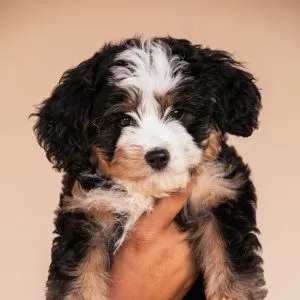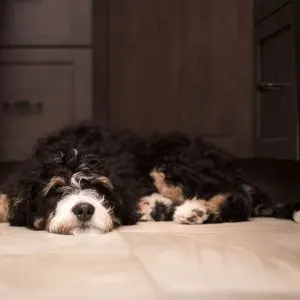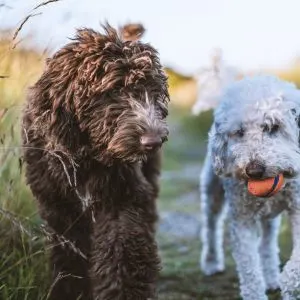Updated: 09/12/2023 – The world of Bernedoodle generations is filled with an assortment of coat colors, fur types, personalities, and sizes, thus making them a popular choice for people looking for the perfect pup to fit their lifestyle.
While each Bernedoodle is unique in their own right, their genetic backgrounds are equally diverse, giving rise to the various generation classifications, including F1, F1b, F2, F2b, F3, and multi-generation.
Deciphering these codes might seem tricky if you’re not a breeder, but don’t worry, we’re here to make it easier for you.
In this guide, we’ll explore the reasons behind creating these Bernedoodle generation classifications. Plus we will break down what each code means in terms of coat characteristics, pricing, temperament, sizing, shedding, and health.
Join us as we unravel the world of Bernedoodle generations and help you make an informed choice for your next furry companion.
Why Were Bernedoodle Generation Classifications Created?
Bernedoodle generation classifications were introduced to help breeders and prospective dog owners understand the genetic makeup and characteristics of individual mixed breed dogs. The primary reasons for creating these classifications are:

- Predictability: By categorizing Bernedoodles into different generations, breeders and buyers can have a reasonable expectation of a dog’s appearance, temperament, and health characteristics. This allows for a more informed decision-making process when selecting a puppy.
- Allergen Friendliness: Some individuals have allergies or sensitivities to dog dander. Understanding the generation of a Bernedoodle can help people choose a dog with a coat that is closely related to the poodle’s coat and is less likely to trigger allergies.
- Consistency: The goal of breeding is to produce dogs with consistent traits and qualities. Generational classifications help breeders work towards this goal by providing a clear framework for selective breeding.

Bernedoodle Generation Classifications are not always consistent
While the Bernedoodle generation classifications provide a framework for understanding certain characteristics, they are not always entirely predictable due to several factors:
- Genetic Variability: Even within the same generation, individual puppies can inherit different combinations of genes from their parents. This genetic variability can result in variations in coat type, color, size, temperament, and health all within a single litter.
- Environmental Factors: Environmental factors, including diet, exercise, and socialization, can play a significant role in a Bernedoodle’s development.
- Selective Breeding Goals: Some breeders prioritize specific traits over others in their breeding programs. This can lead to variations in the traits and characteristics of Bernedoodles from one breeder to another, even within the same generation.

Decoding the Bernedoodle Generations
What does “F” stand for?
The “F” in the terms “F1” and “F1b” etc. stands for “Filial”. It is a genetic term used to describe the generation or degree of hybridization in a breeding program.
In the context of Bernedoodles and other hybrid dog breeds, “F1” and “F1b” refer to different generations of dogs resulting from specific crosses. Here are a couple of examples:
- F1 (First Generation): An F1 Doodle is the product of breeding a purebred non-poodle with a purebred Poodle. The resulting puppies are considered the “first filial generation” because they are the first generation of offspring from two distinct purebred parent breeds. In this situation the doodle will have a 50% genetic makeup from each parent breed.
- F1b (First Generation Backcross): An F1b Doodle, on the other hand, is the result of crossing an F1 Doodle (first generation) with a Poodle. The “b” in F1b stands for “backcross.” This generation introduces more Poodle genetics into the mix, typically resulting in a dog with a higher percentage of Poodle genes.
Looking for a Bernedoodle? Consider getting a Bernedoodle Rescue.
Bernedoodle Generations Explained – Info-graphic

F1, F1b, F2, F2b, F3 and Multigeneration Explained
Now, let’s break down the various Bernedoodle generations and what each one signifies:
F1 Bernedoodle (First Generation)
The F1 Bernedoodle is the result of breeding a Bernese Mountain Dog (BMD) with a Poodle. This generation typically has a 50% BMD and 50% Poodle genetic makeup. Their coats can vary, with some leaning more towards the Bernese side and others favoring the Poodle’s curly, low-shedding coat.
- Coat: F1 Bernedoodles may have a range of coat types, from wavy to curly. Coat length and shedding tendencies can vary within this generation.
- Price: F1 Bernedoodles are often less expensive than subsequent generations, making them a popular choice for those on a budget.
- Temperament: Their temperament combines the affectionate and loyal nature of the Bernese Mountain Dog with the intelligence and trainability of the Poodle.
- Shedding: Shedding can be moderate in F1 Bernedoodles, depending on their specific coat type.
- Health: F1 Bernedoodles can still inherit some genetic health issues from their parent breeds, but they tend to be healthier than purebred dogs due to their mixed genes.
- Size: F1 mini Bernedoodles can have a large size variance within the same litter due to the vastly different size of the parent breeds. Sometimes you will need to wait until your bernedoodle is fully grown before you know their true size. Standard sized Bernedoodles will typically fall in the medium to large range.
F1b Bernedoodle (First Generation Backcross)
The F1b Bernedoodle is the result of crossing an F1 Bernedoodle with one of the parent breeds. Most often this crossback is done using a Poodle. This cross typically has a higher percentage of Poodle genetics, usually around 75% Poodle and 25% BMD. This increase in Poodle genetics often results in a curlier, more hypoallergenic coat.
- Coat: F1b Bernedoodles usually have a curly, low-shedding coat, making them an option for someone with pet dander allergies.
- Price: Due to their hypoallergenic qualities, F1b Bernedoodles are often priced higher than F1s.
- Temperament: They inherit the intelligence and trainability of the Poodle, along with the Bernese Mountain Dog’s affectionate nature. But they may lean more towards the Poodle’s personality.
- Shedding: Shedding is typically less than an F1 Bernedoodle, but they may still shed more than a poodle.
- Health: F1b Bernedoodles tend to be healthier due to their increased Poodle genetics. But they are now more susceptible to health conditions that affect the poodle.
- Size: F1b mini Bernedoodles tend to be smaller than F1 minis, thanks to their increased mini Poodle genetics. They are more likely to fall into the mini or petite Bernedoodle category, making them a popular choice for those seeking smaller companions. Even standard sized F1b Bernedoodles may be smaller than a first generation cross due to the increase in poodle genetics.
F2 Bernedoodle (Second Generation)
The F2 Bernedoodle is the result of breeding two F1 Bernedoodles. This Bernedoodle generation has the most variations when it comes to coat type, temperament, shedding, health and size. Although breeders like to say that this generation retains a 50% BMD and 50% Poodle genetic makeup, the reality is that no one knows which genes are being passed down to the offspring. This results in a greater variability within the F2 generation.
- Coat: Coat types in F2 Bernedoodles can range from wavy to curly, with moderate shedding.
- Price: F2 Bernedoodles are generally more expensive than F1b or F2b generations.
- Temperament: Their temperament can vary, but they typically exhibit a blend of traits from both parent breeds.
- Shedding: Shedding can be moderate in F2 Bernedoodles, depending on their specific coat.
- Health: F2 Bernedoodles may inherit some genetic health issues from either the poodle or Bernese Mountain Dog, but generally enjoy hybrid vigor.
- Size: F2 Bernedoodles, like F1s, can range from mini to large in size, depending on the specific genes inherited from their parents.

F2b Bernedoodle (Second Generation Backcross)
The F2b Bernedoodle is the result of crossing an F2 Bernedoodle with a Poodle. You can also crossback to the Bernese Mountain dog, but this is less common.
Just like with the F1b, this generation has a higher percentage of Poodle genetics, usually around 62.5% Poodle and 37.5% BMD. However, once you get past the first generation, it is hard to tell which genes are passed down without genetic testing.
- Coat: F2b Bernedoodles have a curly, low-shedding coat, similar to F1b Bernedoodles.
- Price: They are typically priced similarly to F1b Bernedoodles.
- Temperament: F2b Bernedoodles have a temperament that combines the intelligence and trainability of the Poodle with the affection of the Bernese Mountain Dog.
- Shedding: Shedding is minimal in F2b Bernedoodles, making them a better choice for allergy sufferers that really want a Bernedoodle.
- Health: F2b Bernedoodles tend to be healthier due to their higher Poodle genetics.
- Size: F2b mini Bernedoodles are generally smaller than F2s. Their size tends to be more consistent due to their increased Poodle genetics.
F3 Bernedoodle (Third Generation)
The F3 Bernedoodle is the result of breeding two F2 Bernedoodles. This generation, like the F2s, is believed to retain a 50% BMD and 50% Poodle genetic makeup. However, there is probably more variation in their genetic make-up than a 50/50 split. This results in greater variability in coat type and temperament within the F3 generation. It is rare to find a F3 Bernedoodle puppy for sale these days.
- Coat: Coat types in F3 Bernedoodles can range from wavy to curly, with moderate shedding.
- Price: F3 Bernedoodles are typically priced similarly to F2 Bernedoodles.
- Temperament: Their temperament can vary, but they generally exhibit a blend of traits from both parent breeds.
- Shedding: Shedding can be moderate in F3 Bernedoodles, depending on their specific coat.
- Health: F3 Bernedoodles may still inherit some genetic health issues but generally enjoy hybrid vigor.
- Size: F3 Bernedoodles can range from medium to large, similar to F2s, depending on the specific combination of genes inherited.
Multi-Generations Bernedoodle
Multi-generation Bernedoodles are the result of breeding Bernedoodles from various generations, including F1, F1b, F2, F2b, F3, and so on. These dogs have a more diverse genetic background. Breeders of later Bernedoodle generations focus more on specific traits they want to see in the dogs rather than the generation.
- Coat: Carefully bred multi-generation Bernedoodles will have less variation in their coat types, with many breeders striving for a wavy, or slightly curly coat. However if the breeder is not deliberate with their breeding practices they can end up with a wide range of coat types.
- Price: The price of multi-generation Bernedoodles can vary depending on their specific genetic makeup and traits. However they tend to cost more than the other generations.
- Temperament: Their temperament can vary greatly, as it is influenced by the mix of different generations in their lineage.
- Shedding: Shedding in multi-generation Bernedoodles can range from minimal to moderate, depending on the individual dog and breeding program.
- Health: Multi-generation Bernedoodles may inherit some genetic health issues from their lineage but often enjoy hybrid vigor due to their diverse genetics.
- Size: Multi-generation Bernedoodles can vary in size, from mini to standard, depending on their genetic heritage.

Bernedoodle Generations in a Nutshell
Bernedoodle generation classifications were created to help breeders and potential dog owners understand the genetic makeup and characteristics of these lovable mixed-breed dogs.
While Bernedoodle generations can provide a general guideline for what to expect, it’s important for potential owners to understand that individual puppies can still vary within these classifications.
When choosing a Bernedoodle, it’s essential to work closely with a reputable breeder who can help match you with a puppy that aligns with your preferences and lifestyle, rather than relying solely on generation classifications.
Before getting a Bernedoodle make sure you know what you are getting into. While these lovable dogs are great for experienced dog parents, Bernedoodles may not be for everyone.
